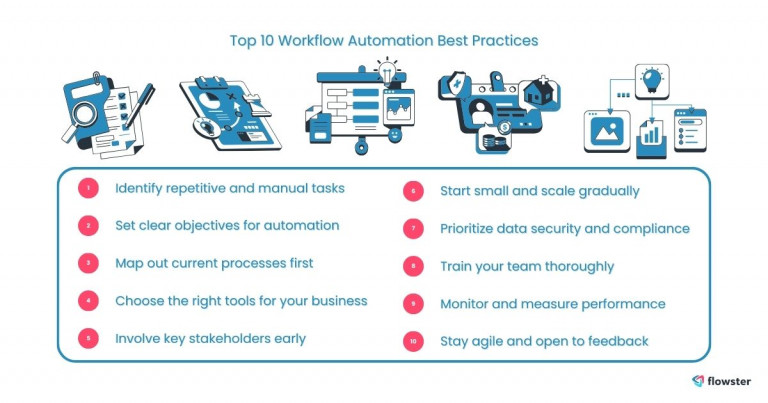Workflow automation isn’t just for big corporations anymore. Automating repetitive tasks can save serious time and cut down on human error, whether you’re running a small team or managing a growing business.
However, implementing automation without a plan can quickly lead to chaos. Many businesses hit roadblocks because they overlook simple steps or choose tools that don’t quite fit. In fact, 36% of organizations report lacking proper standards and a dedicated IT function to oversee automation, which makes it much harder to scale technology effectively and consistently across the business.
That’s why this guide focuses on workflow automation best practices. We’ll walk through smart, actionable tips to help you streamline processes, boost productivity, and actually make automation work for your business.
Article Outline
1. Identify Repetitive and Manual Tasks
Starting automation requires identifying time-consuming tasks. These are often the manual, repetitive jobs that slow your team down and are prone to errors.
Analyze and Spot Inefficiencies
Start by observing daily operations. Where are delays happening? Which tasks get repeated over and over? Time-tracking tools or simple team surveys can give you clarity on what’s dragging productivity.
Focus on High-Volume, Rule-Based Tasks
The best candidates for automation follow a consistent set of rules. Think invoice processing, onboarding emails, or data entry. These tasks don’t require much human judgment, making them perfect for streamlining.
Identifying the right processes is one of the most overlooked workflow automation best practices, but it sets the tone for a successful rollout. Once you know what to automate, you’ll avoid wasting time on the wrong things and start seeing results faster.
2. Set Clear Objectives for Automation
Once you’ve identified what to automate, the next step is to define why you’re doing it. Clear objectives keep your automation efforts focused and measurable.
Define What Success Looks Like
Before diving into tools or workflows, outline what a “win” would be. Is it saving 10 hours a week? Would it be possible to reduce human errors by 30%? These goals give your team direction and help justify the investment.
Connect Automation to Business Goals
Good automation isn’t just about speed—it should support your bigger business strategy. Whether it’s improving customer service or cutting operational expenses, aligning your efforts with company-wide goals is one of the smartest workflow automation best practices.
Having these objectives in place makes it easier to choose tools, set KPIs, and get team buy-in. It also gives you a clear baseline for measuring impact later on.
3. Map Out Current Processes First
Jumping into automation without knowing your current process is like building a house without a blueprint. Before you automate anything, you need to understand how things work right now.
Document Existing Workflows
Take time to write down how tasks move through your organization. Who’s responsible for what? Where are the handoffs and delays? This step is essential for spotting inefficiencies and ensuring the new workflow mirrors or improves upon the old one.
Use Visual Mapping Tools for Clarity
Flowcharts, diagrams, or even simple whiteboard sketches can help you visualize how processes flow. Tools like Lucidchart or Miro make the process easy and collaborative.
Mapping things out gives your team a shared understanding of what’s happening behind the scenes. It also helps you identify where automation can have the biggest impact—another key part of workflow automation best practices.
Flowster's AI-Driven Automation
4. Choose the Right Tools for Your Business
There’s no shortage of workflow automation tools out there—but not all of them will be a good fit for your team. Selecting the appropriate tool can significantly impact your automation success.
Consider Key Factors Like Scalability
Think beyond your immediate needs. Will the tool grow with your business? If you’re planning to expand your automation down the line, make sure the software can handle more complex workflows and users.
Look for Seamless Integrations
One of the top workflow automation best practices is choosing tools that play effectively with your existing tech stack. Check if the platform integrates with your CRM, project management tools, or communication apps like Slack or Microsoft Teams.
Prioritize Ease of Use
Even the most powerful software is useless if your team can’t figure it out. Go for intuitive platforms with drag-and-drop builders, clear documentation, and strong customer support.
The correct tool completes tasks and enables your team to confidently construct, modify, and expand automations. Take your time with this step. It’s worth the effort.
5. Involve Key Stakeholders Early
Obtaining support from the appropriate individuals can significantly impact the success of your automation project. You need support from decision-makers and hands-on team members alike.
Get Department Heads and Team Leads On Board
They know where the inefficiencies are—and how automation could help. By involving them early, you’re more likely to uncover opportunities and avoid resistance later on.
Involve Frontline Employees Too
Don’t overlook the people actually doing the work. Their input helps ensure the automated workflows match real-world needs. Plus, involving them creates a sense of ownership, which improves adoption.
Why Early Buy-In Matters
When stakeholders feel like they’re part of the process, they’re more likely to champion the change. One of the most effective workflow automation best practices is treating automation as a team effort, not a top-down mandate.
Bringing everyone to the table from the start sets the stage for smoother rollouts, fewer surprises, and better long-term results.
6. Start Small and Scale Gradually
Automation can be exciting, but going all-in too quickly can backfire. It’s smarter to begin with one process and build from there.
Pilot a Single Workflow or Department
Choose one area where automation could make an immediate impact. Maybe it’s automating client onboarding or streamlining internal requests. Starting small helps you test tools, train your team, and resolve issues without overwhelming everyone.
Learn and Optimize Before Expanding
Once the pilot is running smoothly, use what you’ve learned to improve and scale. You’ll get valuable feedback from users and identify areas for refinement. This gradual approach is a core piece of workflow automation best practices.
Scaling automation doesn’t need to be rushed. Taking the time to get it right from the start sets you up for long-term success—and avoids costly missteps later on.

7. Prioritize Data Security and Compliance
Automation often involves handling sensitive business and customer information—so protecting that data should be a top priority.
Ensure Strong Data Protection Measures
Any tool you use should offer features like encryption, access control, and secure backups. Ask vendors how they handle your data and make sure your IT team is involved in the evaluation.
Meet Industry Compliance Standards
If you’re in a regulated industry (like healthcare or finance), double-check that your chosen platform meets compliance requirements like HIPAA, GDPR, or SOC 2. Ignoring these requirements can lead to legal issues and major trust problems.
Among all the workflow automation best practices, this one helps you avoid major risks. It’s not just about preventing a breach—it’s about building trust with your customers and stakeholders.
8. Train Your Team Thoroughly
Even the best automation tools won’t deliver results if your team doesn’t know how to use them. Proper training is essential for a smooth transition.
Create Easy-to-Follow Training Programs
Build step-by-step guides or video tutorials to walk your team through the new workflows. Make the content simple and practical so they can quickly understand how automation helps their daily tasks.
Support Ongoing Education
Automation tools evolve. Keep your team updated on new features, changes, or best practices. Hosting short refreshers or sharing tips in team meetings helps reinforce learning.
Training is one of those underrated workflow automation best practices that can make a big difference in adoption rates. The more confident your team feels, the more value you’ll get from automation.
9. Monitor and Measure Performance
You can’t improve what you don’t measure. Tracking performance helps you understand what’s working—and what’s not.
Track the Right KPIs
Focus on metrics like time saved, task completion rates, reduced errors, and overall ROI. These numbers tell the story of how well your workflows are performing.
Use Insights to Make Smart Improvements
Don’t simply configure and forget about it. Use reports and feedback to tweak your automations. Small changes—like adjusting triggers or timing—can lead to better efficiency and happier teams.
Among the best practices for workflow automation, closely monitoring performance ensures that your efforts remain aligned with business goals and continue to deliver value over time.
10. Stay Agile and Open to Feedback
Even the best automation strategy will need some fine-tuning over time. Staying flexible helps you keep things running smoothly as your business evolves.
Promote Regular Reviews and Adaptability
Set checkpoints to review your workflows and spot opportunities for improvement. This habit helps you stay ahead of issues and adapt as your processes change.
Encourage Feedback Loops from Users
Your team is the best source of insights. Create easy ways for them to share what’s working and what’s frustrating. This ongoing feedback is gold for refining and expanding your automation.
Of all the workflow automation best practices, staying agile keeps your systems effective, relevant, and aligned with your team’s real-world experience.
Capture Your Processes in Minutes!
Final Thoughts on Workflow Automation Best Practices
By now, you’ve noticed that successful workflow automation isn’t just about plugging in software—it’s about having a smart, scalable strategy and involving your team every step of the way.
Quick Recap: Top 10 Workflow Automation Best Practices
- Identify repetitive and manual tasks
- Set clear objectives for automation
- Map out current processes first
- Choose the right tools for your business
- Involve key stakeholders early
- Start small and scale gradually
- Prioritize data security and compliance
- Train your team thoroughly
- Monitor and measure performance
- Stay agile and open to feedback
These ten workflow automation best practices are designed to help you avoid common pitfalls and build systems that truly work for your business. Whether you’re looking to save time, reduce errors, or scale faster, every step counts.
If you’re ready to put these tips into action, give Flowster a try. It’s a powerful, user-friendly platform that helps businesses like yours automate processes quickly and effectively—no tech wizardry required.
Use this free Workflow Automation Checklist to make setting up your workflow automation way easier.
Let your workflows work for you. Start today with Flowster.




